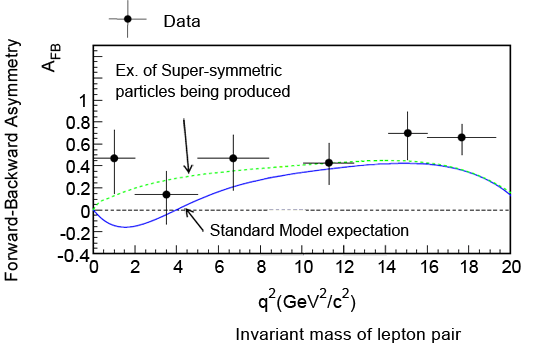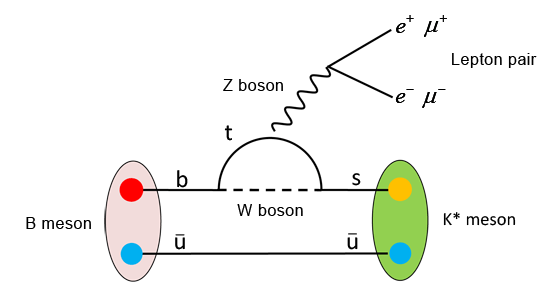| |
 |
Press Release |
|
 |
Belle Finds a Hint of New Physics in Extremely Rare B Decays
|
August 22, 2009
High Energy Accelerator Research Organization (KEK)
|
Quarks, the most fundamental constituents of matters, are classified into six species grouped into three generations as predicted by Professors Kobayashi and Maskawa. The purpose of the B factory experiment is to elucidate the fundamental laws of elementary particles by producing B mesons that contain the second heaviest quark (bottom). An international team of researchers at the High Energy Accelerator Research organization (KEK) in Tsukuba, Japan, the "Belle collaboration"*1, has achieved many successes, including the discovery of CP violation in B meson decays and proof of the Kobayashi-Maskawa theory, the discoveries of new decay processes in B decays and D-meson mixing as well as the observation of new resonances. The performance of the KEKB accelerator has been further improved and achieved a peak luminosity exceeding twice its design value in June 2009. Belle has accumulated about 800 million B and anti-B meson pairs. In particular, Belle has recently analyzed angular distributions of leptons in B mesons that decay into a K* meson (an excited state of a K meson) and a lepton anti-lepton pair (here lepton stands for an electron or a muon), using 660 million pairs of B and anti-B mesons; the observed results are larger than the Standard Model expectation and provide a hint of new physics beyond the Standard Model.
These results were presented at the Lepton-Photon International Symposium taking place from August 17th in Hamburg, Germany.
Figure 1 shows the forward-backward asymmetries of a positively charged lepton with respect to the direction of a K* meson in B decays to a K* and a lepton pair. The measured data points are above the Standard Model expectation (solid curve). In the Standard Model, this decay mode proceeds via the "Penguin diagram" shown in Fig. 2. This type of decay proceeds via intermediate particles, such as a Z-boson or a W-boson, which are much heavier than the B meson. According to the Heisenberg's uncertainty principle, it is possible to produce such heavy particles for a very short time. New heavy particles beyond those in the Standard Model are also expected to be produced in a similar way. Super-symmetric particles are considered as most promising candidates. A measurement of the lepton forward-backward asymmetry is an excellent way to probe the nature of such heavy particles. Since the measured data points are closer to the expectation when super-symmetric particles are produced (dashed curve in Fig.1), the difference between the measurements and the Standard Model expectation may indicate that such new physics particles are produced in addition to Z and W -bosons.
This decay process was discovered by the Belle in 2002. However, the measurement of the lepton forward-backward asymmetry has been quite difficult due to the very small decay rates. It has become possible only with increased data samples thanks to the improved performance of the KEKB accelerator. About 250 signal evens are obtained in this analysis.
There are various processes involving Penguin diagrams and other hints for new physics have been found, such as the difference in CP violation between neutral and charged B decays to a K meson and a  meson. The observed D-meson mixing is unexpectedly large and close to the upper limit of Standard Model expectations; this may also indicate the effect of new physics. In order to clarify whether these hints are due to new physics or not, Belle continues measurements with a larger accumulated data sample. meson. The observed D-meson mixing is unexpectedly large and close to the upper limit of Standard Model expectations; this may also indicate the effect of new physics. In order to clarify whether these hints are due to new physics or not, Belle continues measurements with a larger accumulated data sample.
[ Media Contact ] Youhei Morita, KEK Public Relations Office
+81 29-879-6047
|
 |
Figure 1 : The results of lepton angular distribution measurements in B decays to a K* meson and a lepton pair. The vertical axis shows the forward-backward asymmetry of a positively charged lepton with respect to a K* meson. The horizontal axis shows the invariant mass of the lepton pair. The points with error bars are data, the solid curve is the Standard Model expectation, and the dotted curve is an example of a model where super-symmetric particles are produced in the decay.
|
 |
Figure 2 : Schematic view of a B decay to a K* meson and a lepton pair (Penguin diagram).
|
|
| |
| *1: | The "Belle collaboration" is an international team of about 370 faculty, postdoctoral and student researchers from 61 institutes (universities and laboratories) located in 15 different countries and regions.
|
|



